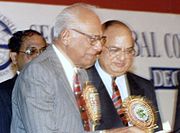- Cheddi Jagan Bio Diversity Park
-
Cheddi Jagan Bio-Diversity Park was established in 2001 in memory of patriot and national hero Dr. Cheddi Jagan by Isahak Basir CCH.
It is located on a historical site created by slaves in the period of the 18th century and also a symbol of action that lead to the final closure of Hampton Court Estate in 1943 being the last of the 34 sugar mills in Essequibo.History - September 2001
The Dr. Cheddi Jagan Bio Diversity Park was identified in September 2001 and officially opened on March 23, 2002 by Minister Clement Rohee M.P., Ally Baksh - Regional Chairman, Vishnu Samaroo - Vice Chairman and Sabra Basir A.A. The idea of identifying an appropriate park consistent with Dr. Cheddi Jagan concept and likeness and love for nature came from Isahak Basir C.C.H. a personality who has had forty years of very close political relations with the late Dr. Cheddi Jagan. Hence the "Lima Sands" located in Essequibo, Region 2, Guyana, South America, was identified. The park is consistently with a variety of flora, fauna and subordinating savannahs - access is by road, west of Anna Regina, parallel to the Tapacooma Main Canals.
History
The entire sea coast from the Corentyne to the Barima River in the North West District was occupied by rivals’ such as the Spaniards, French and the Dutch, even though the Dutch paid for their final occupation.
The Essequibo Coast was no exception; from Supenaam to Better Success each estate owner had his own landing, police and control system. Cotton, coffee and sugar dominate the production, with thirty four sugar mills on the Essequibo Coast lands.
The areas between Reliance and Paradise were dependent on water supply from Tapacooma Lake, which main supply canal was under the control of the Dutch planters of the Anna Regina estate. The stealing of slaves and denial of irrigation was always rebellious situation, consistent with that of the 1763 uprising in Berbice.
The Plutocracy from Richmond to Paradise consisting of eleven estate owners decided in 1788 to engage about 150 slaves to dig a canal North West of the Tapacooma Lake landing to the back of Lima estate, so as to avoid the high charges and sabotage of water supply from Anna Regina owners and slave masters. This effort was met with armed opposition that forced the location of the canal further inland.
However the canal was completed about eight miles cutting the Lima Sands. A wooden koker structure, built in the 1920 is still noticeable. The Lima sand was an escape route for runaway slaves, who were easily captured by Amerindian in the Dredge creek water way, now known as 'Manicuri' Canal.
The word 'Manicuri' is of Locono origin, means "hiding place". The British who took control in 1810 and in 1860 period brought mules and bisons to help in the sugar plantation. Lima Sand became a heaven for escaped bisons, some eventually migrated to Troolie Island and one Sernauth Ally killed the last Bison in 1954 in Danielstown.
The three counties, Essequibo, Demerara and Berbice were merged in 1831 under British occupation, to create British Guyana but each county had their elected representative in control.
By mid 1920, the main contestants for the Demerara court of policy, from Essequibo were Dodds of affiance, Seymour of Reliance and Brashington of Hampton Court. It was a heated election in 1928 and Brashington lost the majority. He became enraged and immediately closed down the Hampton Court estate saying, "Essequibo coolie must perish and wear jute bags for clothing".
He damaged many infrastructures, broke down many logies and destroyed one of the most beautiful chimneys build by the Dutch in Hampton Court. His final assault was to damage a "waterwheel" which prevented Hampton Court from flooding and instructed his remaining disciples to pull a huge "iron cane punt" and block the supply canal of lima that led to the Tapacooma lake and one that led to the Anna Regina hinterland. The iron punts can still be located about 500 meters west of Lima Sands submerged under savannah's vegetation.
The Lima Sands, remote as it is, has a rich history complementary to our survival. The Marsh Plan promulgated in 1957 by the P.P.P Government resulted in the construction of the major Tapakuma project and was commissioned in 1963 by Sir Ralph Grey and Premier Dr. Cheddi Jagan.
The present site for the part was chosen because the hard work of building a huge dam by slaves is still visible, where one can ponder of what our ancestors went through using basket, shovel, spade, enduring the slave masters' whip to build such a landmark.
The Cheddi Jagan Bio Diversity Park was enriched with the "ashes" of a young schoolteacher P.Y.O members Balram Khanhai which was placed in a cornerstone. Balram Khanhai was murdered at the P.P.P. 27th Congress held in Berbice on July 22, 2002.
The memories of Dr. Cheddi Jagan, this great, teacher, father and leader must be preserved and cast in stone, hence the Dr. Cheddi Jagan Bio Diversity Park.
Categories:- Parks in Guyana
- Protected areas established in 2001
Wikimedia Foundation. 2010.

